A Comparison of Faulty Antenna Detection Methodologies in Planar Array
Abstract
1. Introduction
2. Methodology
3. Problem Formulation
3.1. Planar Array Radiation Pattern Generation
3.2. Failed Radiation Pattern Generation
3.3. Types of Failure
3.4. Performance Measure of the Radiation Patterns
4. Optimization Algorithms
4.1. Pattern Search Optimization
4.2. Simulated Annealing Optimization
4.3. Particle Swarm Optimization
5. Results and Discussion
5.1. Modelling Results
5.2. Optimization Results
6. Conclusions
Author Contributions
Funding
Institutional Review Board Statement
Informed Consent Statement
Data Availability Statement
Conflicts of Interest
References
- Rao, S.; Acharya, O.P.; Patnaik, A. Antenna Array Failure Correction [Antenna Applications Corner]. IEEE Antennas Propag. Mag. 2017, 59, 106–115. [Google Scholar]
- Xiong, C.; Xiao, G.; Hou, Y.; Hameed, M. A Compressed Sensing-Based Element Failure Diagnosis Method for Phased Array Antenna During Beam Steering. IEEE Antennas Wirel. Propag. Lett. 2019, 18, 1756–1760. [Google Scholar] [CrossRef]
- Migliore, M.D.; Panariello, G. A comparison of interferometric methods applied to array diagnosis fromnear-fielddata. IEE Proc. Microw. Antennas Propag. 2001, 148, 261–267. [Google Scholar] [CrossRef]
- Lee, J.; Ferren, E.; Woollen, D.; Lee, K. Near-field probe used as a diagnostic tool to locate defective elements in an array antenna. IEEE Trans. Antennas Propag. 1988, 36, 884–889. [Google Scholar] [CrossRef]
- Bregains, J.C.; Ares, F.; Moreno, E. Matrix pseudo-inversion technique for diagnostics of planar arrays. Electron. Lett. 2005, 41, 19–20. [Google Scholar] [CrossRef]
- Lord, J.; Cook, G.; Anderson, A. Reconstruction of the Excitation of Array Antennas from the Measured Near-Field Intensity using Phase Retrieval. In Proceedings of the 1992 22nd European Microwave Conference, Helsinki, Finland, 5–9 September 1992; Volume 1, pp. 525–530. [Google Scholar] [CrossRef]
- Bucci, O.; Capozzoli, A.; D’Elia, G. Diagnosis of array faults from far-field amplitude-only data. IEEE Trans. Antennas Propag. 2000, 48, 647–652. [Google Scholar] [CrossRef]
- Choudhury, B.; Jha, R.M. Fault Detectionin Antenna Arrays. In Soft Computing in Electromagnetics Methods and Applications; Cambridge University Press: Cambridge, UK, 2016; pp. 124–154. [Google Scholar] [CrossRef]
- Patidar, H.; Mahanti, G.K. Failure correction of linear antenna array by changing length and spacing of failed elements. Prog. Electromagn. Res. M 2017, 61, 75–84. [Google Scholar] [CrossRef]
- Khan, S.U.; Rahim, M.K.A.; Aminu-Baba, M.; Murad, N.A. Correction of failure in linear antenna arrays with greedy sparseness constrained optimization technique. PLoS ONE 2017, 12, e0189240. [Google Scholar] [CrossRef] [PubMed]
- Yeo, B.-K.; Lu, Y. Array failure correction with a genetic algorithm. IEEE Trans. Antennas Propag. 1999, 47, 823–828. [Google Scholar] [CrossRef]
- Keizer, W.P.M.N. Element Failure Correction for a Large Monopulse Phased Array Antenna With Active Amplitude Weighting. IEEE Trans. Antennas Propag. 2007, 55, 2211–2218. [Google Scholar] [CrossRef]
- Acharya, O.P.; Patnaik, A.; Choudhury, B. Fault finding in antenna arrays using bacteria foraging optimization technique. In Proceedings of the 2011 National Conference on Communications (NCC), Bangalore, India, 28–30 January 2011; pp. 1–5. [Google Scholar] [CrossRef]
- Patnaik, A.; Christodoulou, C. Finding failed element positions in linear antenna arrays using neural networks. In Proceedings of the 2006 IEEE Antennas and Propagation Society International Symposium, Albuquerque, NM, USA, 9–14 July 2006; pp. 1675–1678. [Google Scholar] [CrossRef]
- Patnaik, A.; Choudhury, B.; Pradhan, P.; Mishra, R.K.; Christodoulou, C. An ANN Application for Fault Finding in Antenna Arrays. IEEE Trans. Antennas Propag. 2007, 55, 775–777. [Google Scholar] [CrossRef]
- Yadav, K.; Singh, H. Application of iterative fast Fourier transform for fault finding in linear array antenna with various fault percentage. In Proceedings of the 2014 Innovative Applications of Computational Intelligence on Power, Energy and Controls with their impact on Humanity (CIPECH), Ghaziabad, India, 28–29 November 2014; pp. 117–120. [Google Scholar] [CrossRef]
- Khan, S.U.; Qureshi, I.M.; Zaman, F.; Basit, A.; Khan, W. Application of firefly algorithm to fault finding in linear array santenna. World Appl. Sci. J. 2013, 26, 232–238. [Google Scholar] [CrossRef]
- Prajosh, K.P.; Khankhoje, U.K.; Ferranti, F. Fault diagnosis by a novel compressed sensing technique in a phased array with cosine squared element patterns. In Proceedings of the 2021 15th European Conference on Antennas and Propagation (EuCAP), Dusseldorf, Germany, 22–26 March 2021. [Google Scholar] [CrossRef]
- Khan, S.U.; Qureshi, I.M.; Naveed, A.; Shoaib, B.; Basit, A. Detection of Defective Sensors in Phased Array Using Compressed Sensing and Hybrid Genetic Algorithm. J. Sens. 2016, 2016, 6139802. [Google Scholar] [CrossRef]
- Khan, S.U.; Qureshi, I.M.; Zaman, F.; Khan, W. Detecting faulty sensors in an array using symmetrical structure and cultural algorithm hybridized with differential evolution. Front. Inf. Technol. Electron. Eng. 2017, 18, 235–245. [Google Scholar] [CrossRef]
- Chen, Y.-S.; Tsai, I.-L. Detection and Correction of Element Failures Using a Cumulative Sum Scheme for Active Phased Arrays. IEEE Access 2018, 6, 8797–8809. [Google Scholar] [CrossRef]
- Puri, V.; Puri, S. Detection of Defective Element in a Space Borne Planar Array with Far-Field Power Pattern Using Particle Swarm Optimization. J. Electron. Commun. Eng. 2015, 10, 17–22. [Google Scholar] [CrossRef]
- Kusunose, K.; Arai, H. Detection of Defective Element by Cross Scanning Near Field Examination for Symmetrical Planar Array. In Proceedings of the 2019 International Symposium on Antennas and Propagation (ISAP), Xi’an, China, 27–30 October 2019; pp. 5–6. [Google Scholar]
- Mallahza-deh, A.R.; Taherzadeh, M. Element Failure Diagnosis in a Planar Microstrip Array by the Use of Neural Networks. In Proceedings of the 2010 International Conference on Applications of Electromagnetism and Student Innovation Competition Awards (AEM2C), Taipei, Taiwan, 11–13 August 2010; pp. 294–298. [Google Scholar]
- Balanis, C.A. Antenna Theory, 4th ed.; John Wiley & Sons, Inc.: Hoboken, NJ, USA, 2016. [Google Scholar]
- Kumar, V.; Chhabra, J.K.; Kumar, D. Parameter adaptive harmony search algorithm for unimodal and multimodal optimization problems. J. Comput. Sci. 2014, 5, 144–155. [Google Scholar] [CrossRef]
- Katoch, S.; Chauhan, S.S.; Kumar, V. A review on genetic algorithm: Past, present, and future. Multimed. Tools Appl. 2021, 80, 8091–8126. [Google Scholar] [CrossRef]
- Lewis, R.M.; Torczon, V.; Trosset, M.W.; William, C. Direct Search Methods: Thenand Now Operated by Universities Space Research Association. J. Comput. Appl. Math. 2000, 124, 191–207. [Google Scholar] [CrossRef]
- Kenne-dy, J.; Eberhart, R. Particle Swarm Optimisation. In Proceedings of the ICNN’95-International Conference on Neural Networks, Perth, WA, Australia, 27 November–1 December 1995; Volume 4, pp. 1942–1948. [Google Scholar]
- Findler, N.V.; Lo, C.; Lo, R. Pattern search for optimization. Math. Comput. Simul. 1987, 29, 41–50. [Google Scholar] [CrossRef]
- Palacio-Morales, J.; Tobón, A.; Herrera, J. Optimization Based on Pattern Search Algorithm Applied to pH Non-Linear Control: Application to Alkalinization Process of Sugar Juice. Processes 2021, 9, 2283. [Google Scholar] [CrossRef]
- Zewail, I.; Saad, W.; Shokair, M.; El-dolil, S.A. Maximization of Total Throughput Using Pattern Search Algorithm in Underlay Cognitive Radio Network. Menoufia J. Electron. Eng. Res. 2017, 26, 307–319. [Google Scholar] [CrossRef]
- Ingber, L. Adaptive simulated annealing(ASA):Lessons learned. J. Control Cybern. 1996, 25, 33–54. [Google Scholar]
- Eglese, R. Simulated annealing: A tool for operational research. Eur. J. Oper. Res. 1990, 46, 271–281. [Google Scholar] [CrossRef]
- Zhou, A.-H.; Zhu, L.-P.; Hu, B.; Deng, S.; Song, Y.; Qiu, H.; Pan, S. Traveling-Salesman-Problem Algorithm Based on Simulated Annealing and Gene-Expression Programming. Information 2018, 10, 7. [Google Scholar] [CrossRef]
- Mezura-Montes, E.; Coello, C.A.C. Constraint-handling in nature-inspired numerical optimization: Past, present and future. Swarm Evol. Comput. 2011, 1, 173–194. [Google Scholar] [CrossRef]
- Pedersen, M.E. Good Parameters for Particle Swarm Optimization; Hvass Laboratories: Luxembourg, 2010. [Google Scholar]
- Youse-fi, M.; Omid, M.; Rafiee, S.; Ghaderi, S.F. Strategic planning for minimizing CO2 emission susing LP model based on forecasted energy demand by PSO Algorithm and ANN. Int. J. Energy Environ. 2013, 4, 1041–1052. [Google Scholar]
- Boopalan, N.; Ramasamy, A.K.; Nagi, F.H. Faulty antenna detection in a linear array using Simulated Annealing Optimization. Indones. J. Electr. Eng. Comput. Sci. 2020, 19, 1340–1347. [Google Scholar] [CrossRef]
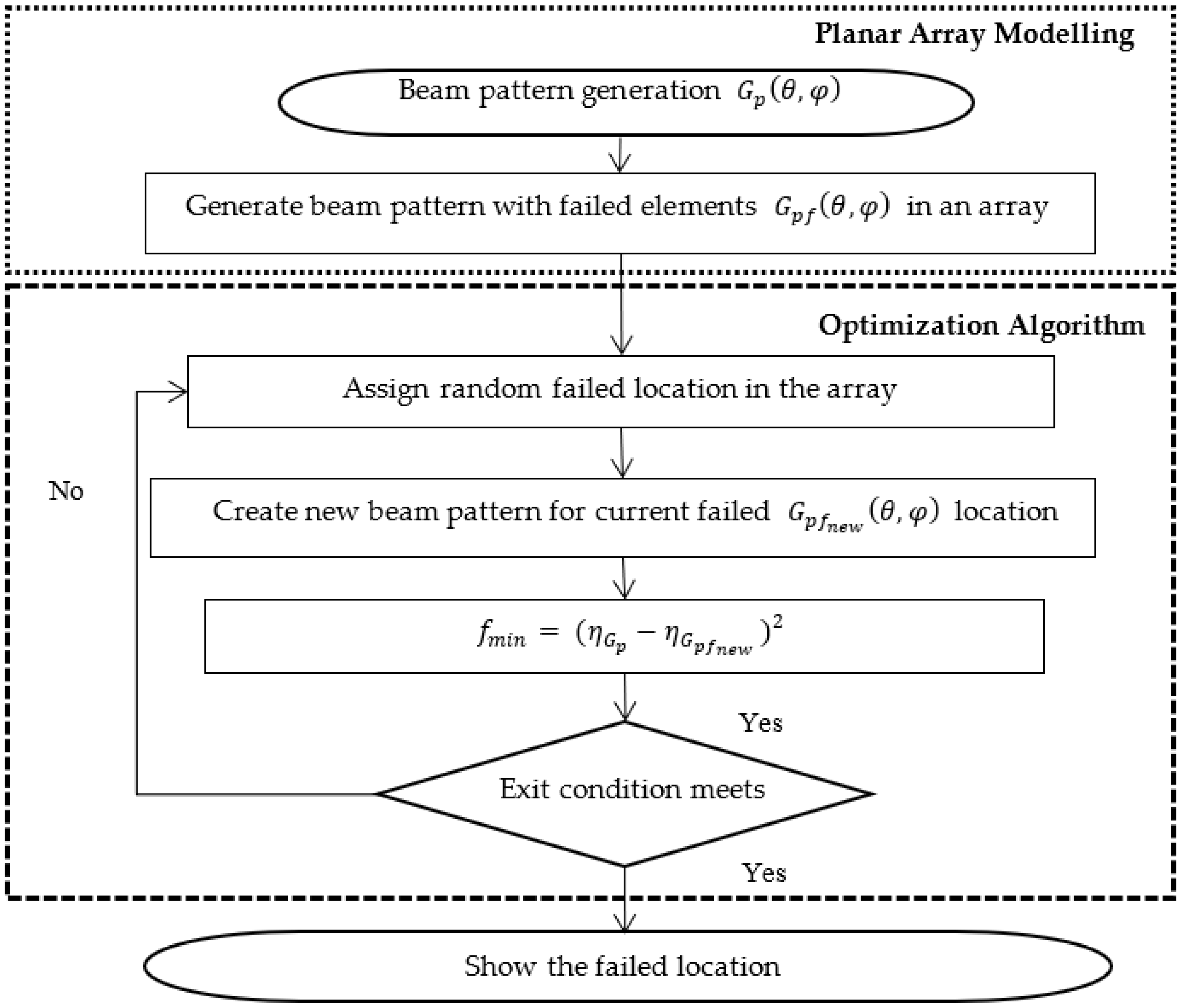

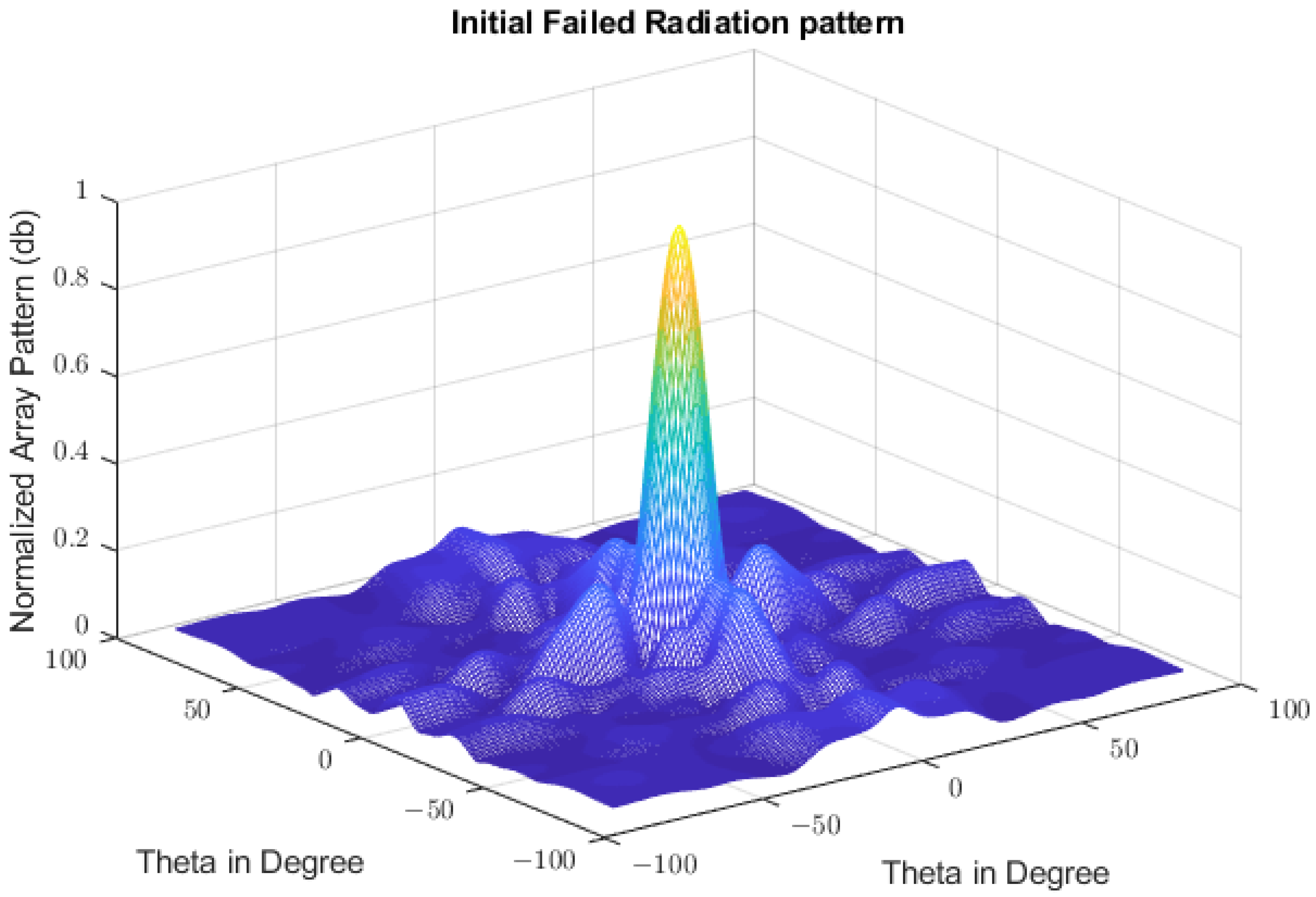

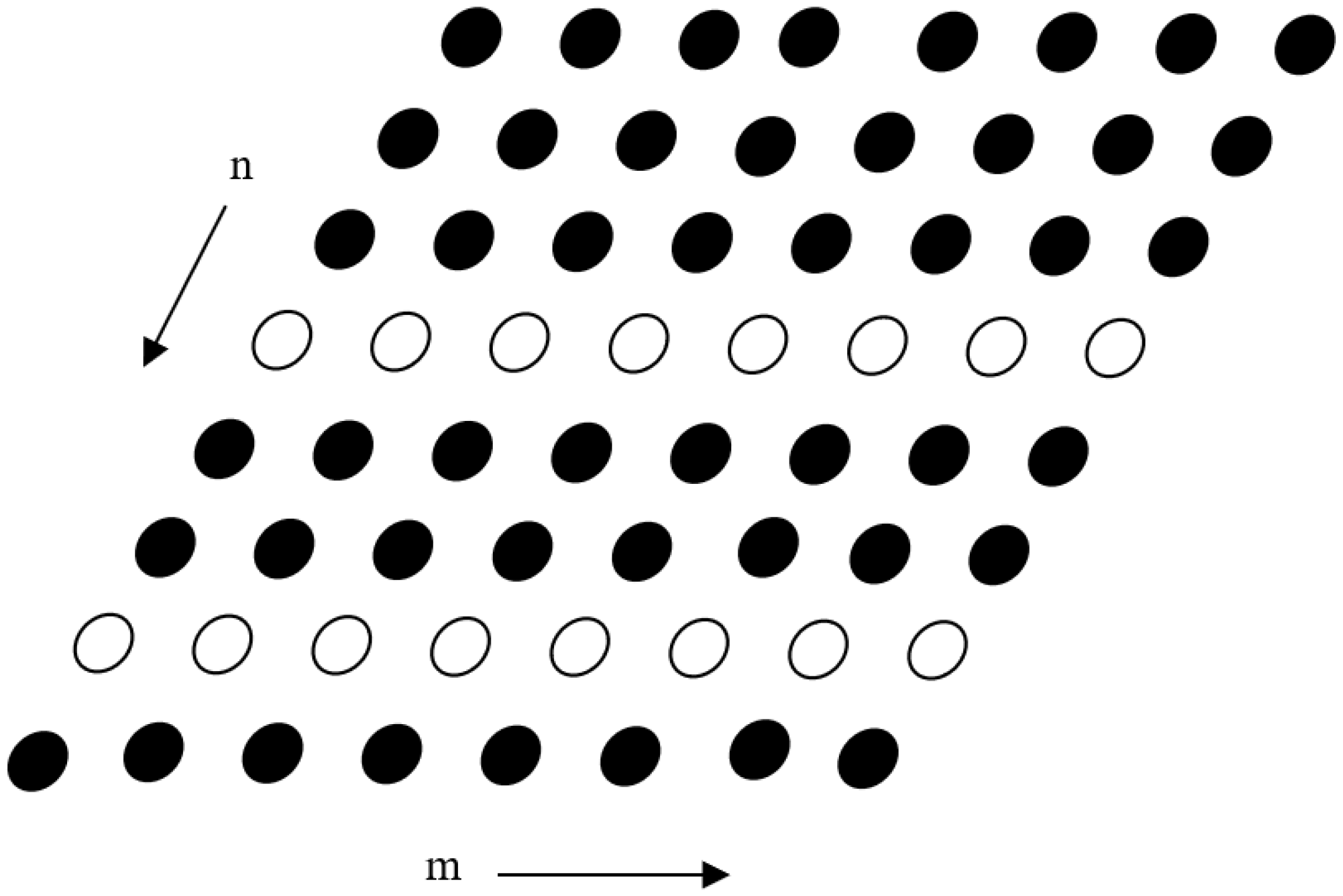
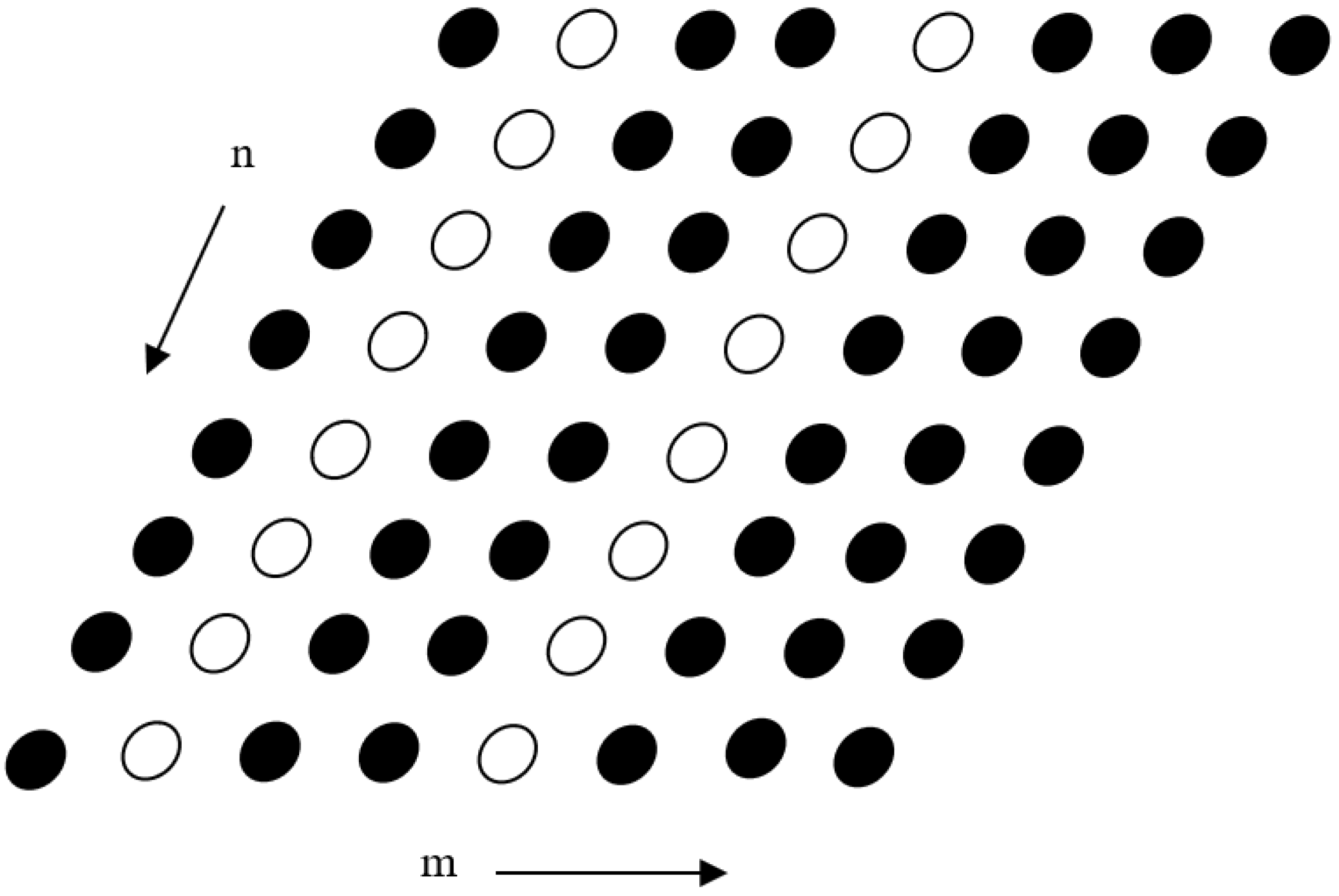



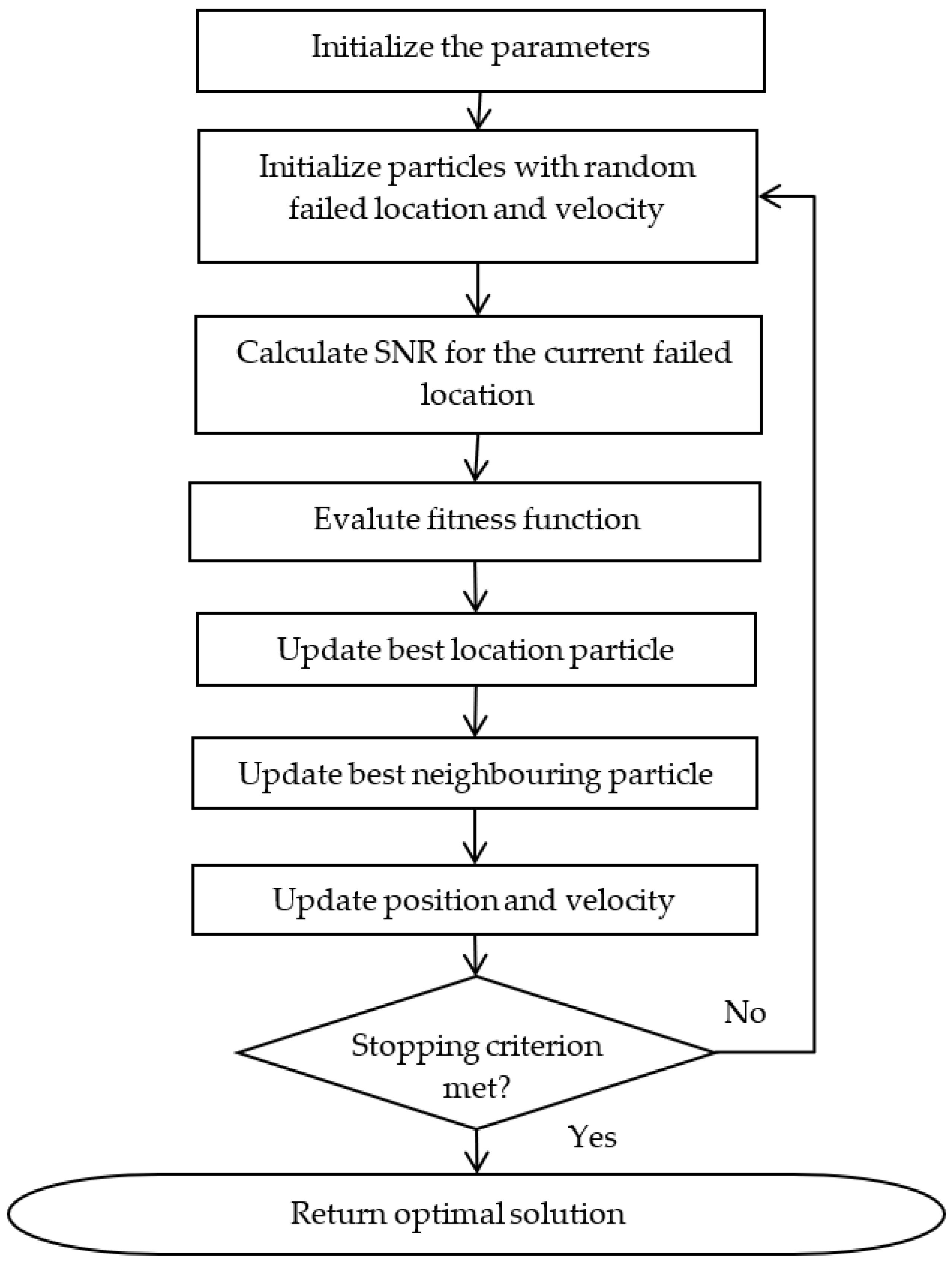
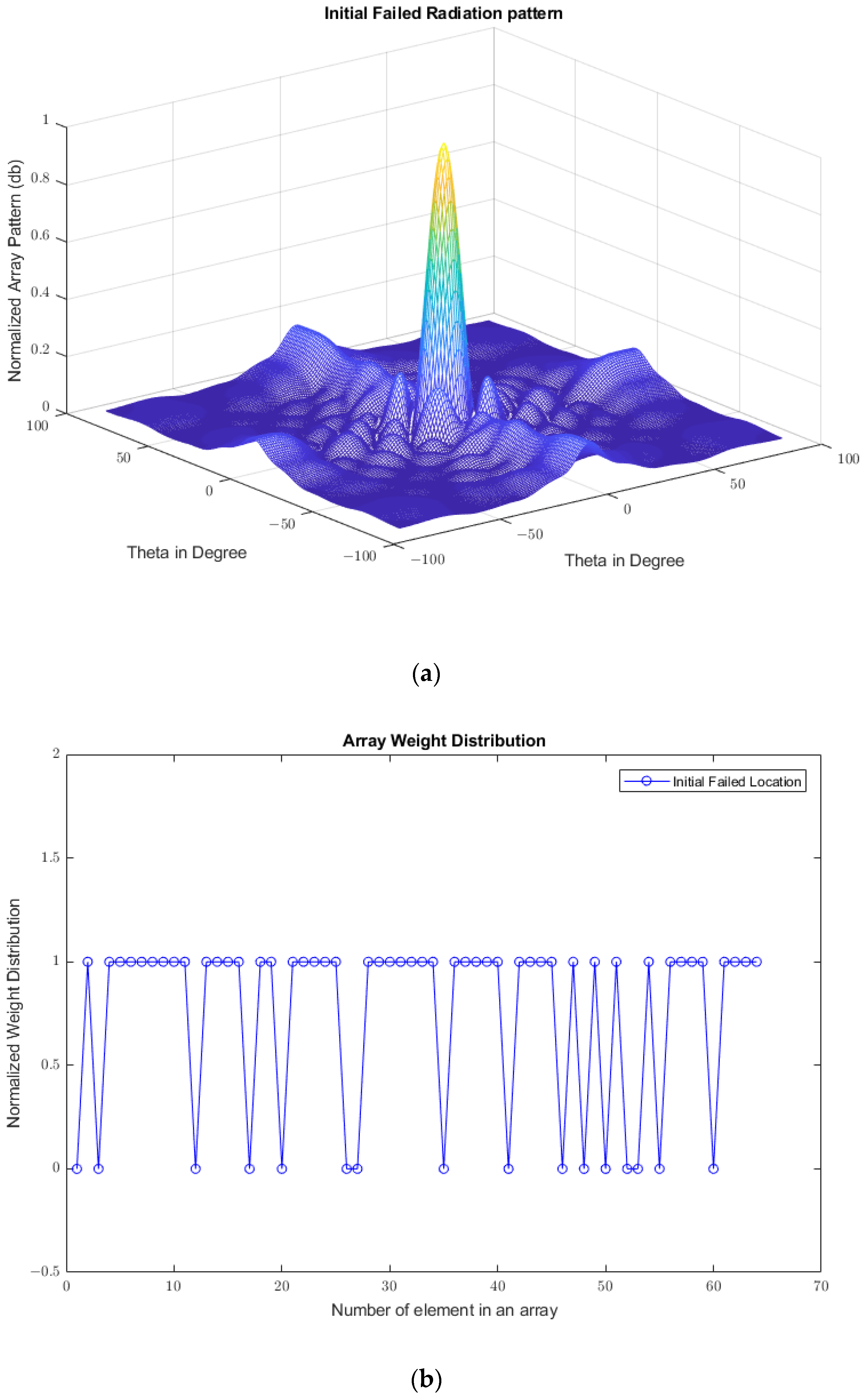
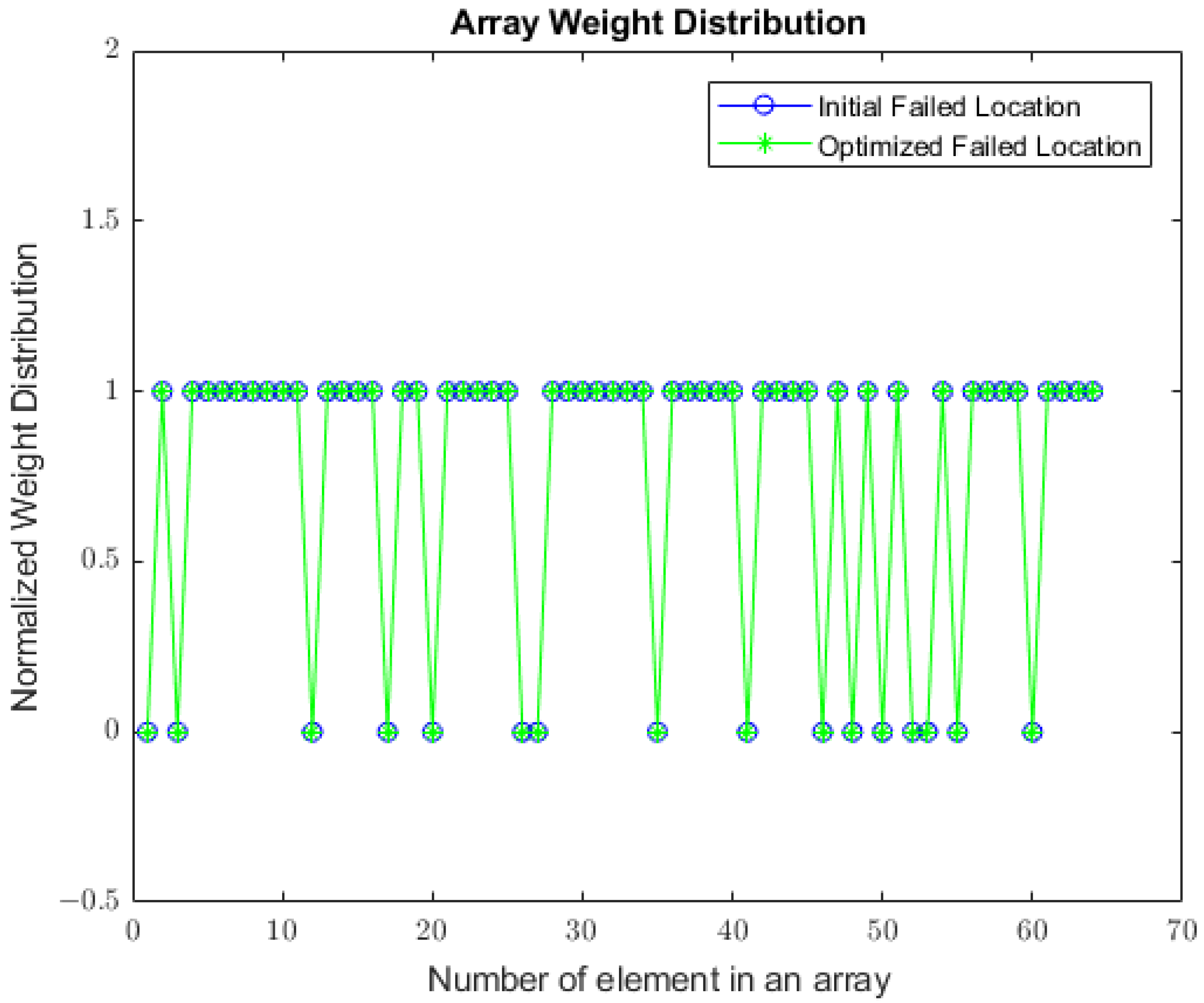

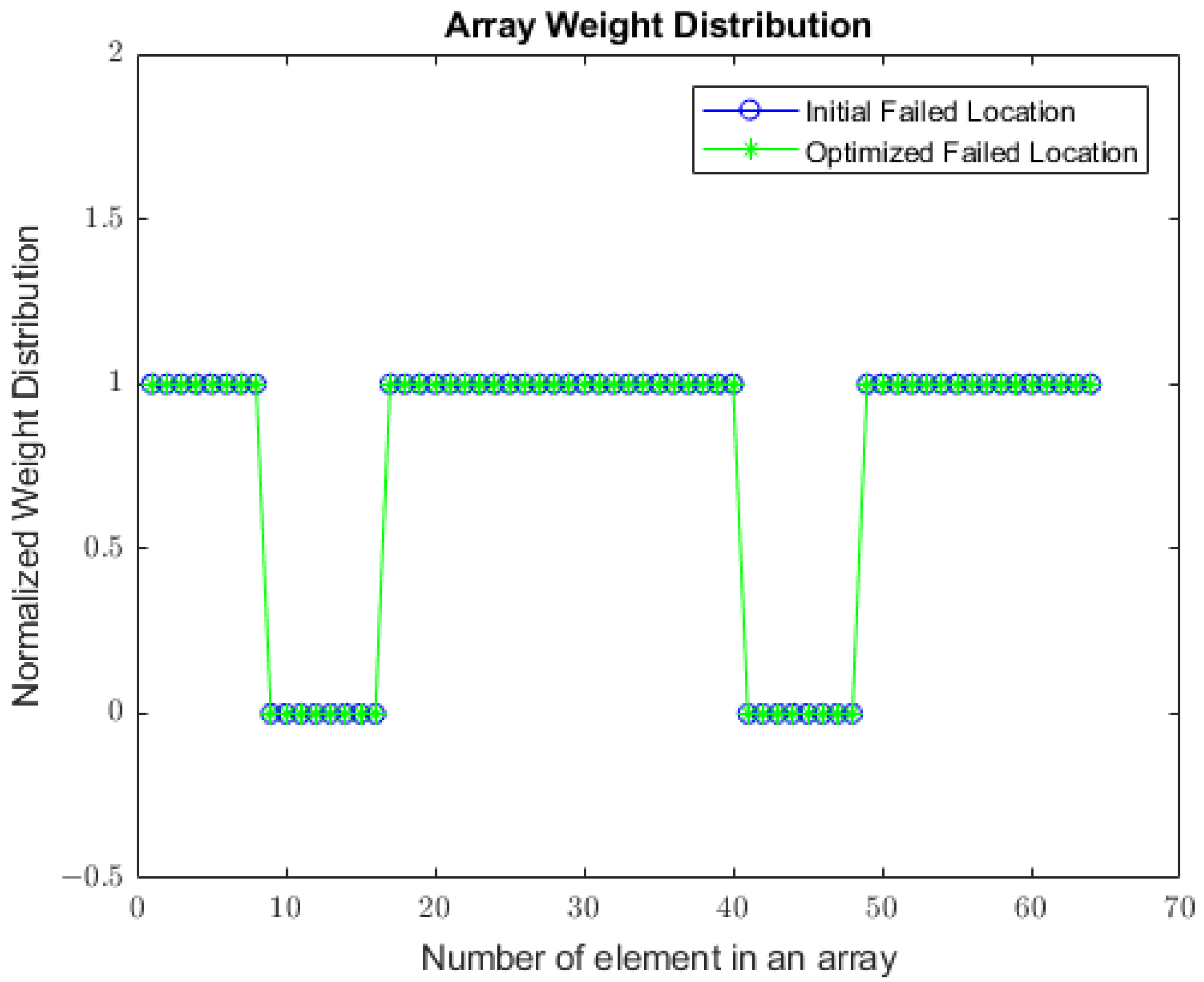
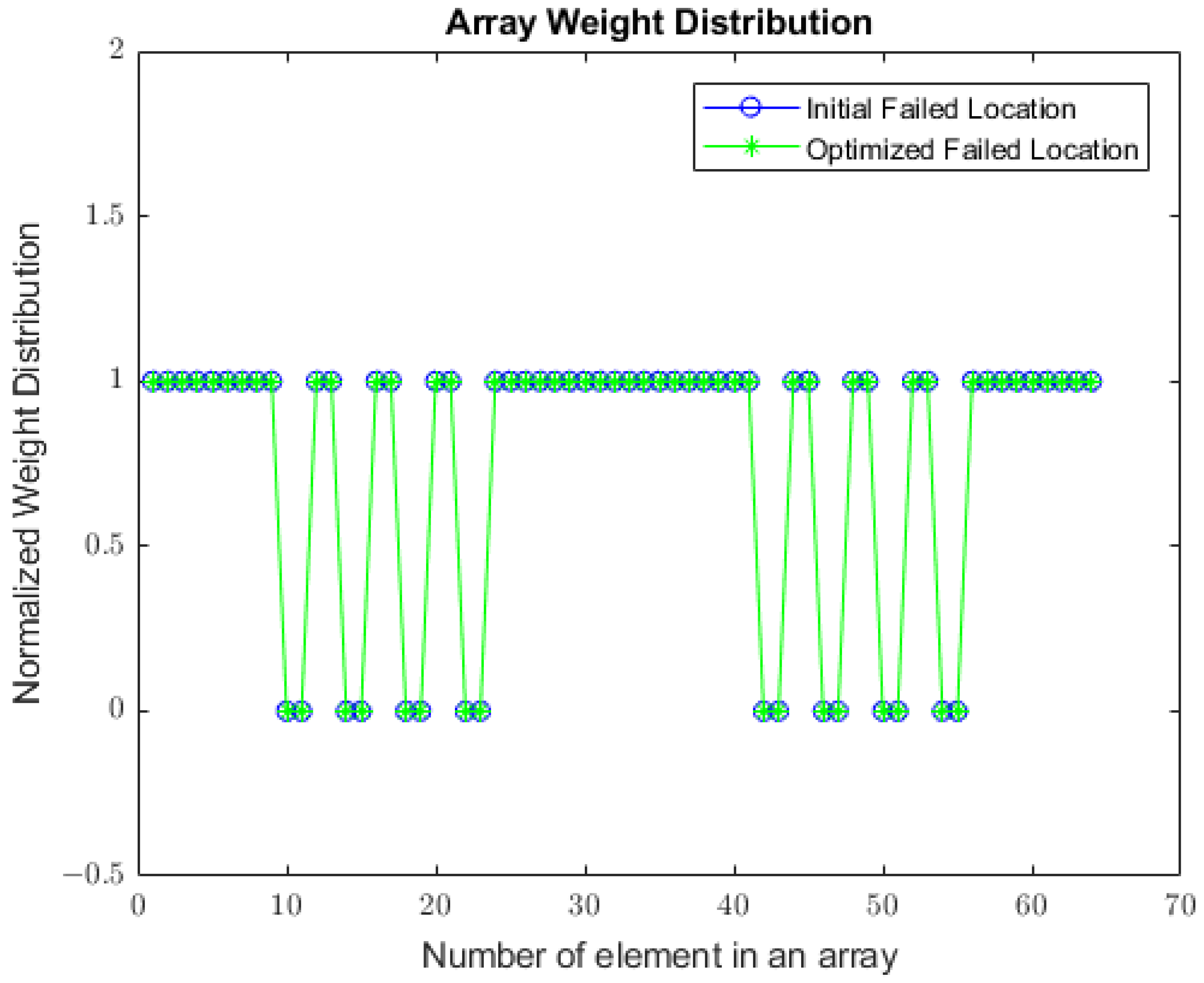
| Failure Type | 16 Failed Elements (8 × 8 Array) | 12 Failed Elements (6 × 6 Array) |
|---|---|---|
| Random | Random locations | Random locations |
| Row | Rows 2, 5 | Rows 2, 5 |
| Column | Columns 2, 5 | Columns 2, 5 |
| Group (2 × 2) | 4 groups | 3 groups |
| Array Size | Failure Type | Remarks | Optimization Method | Detection Accuracy (%) | Average Processing Time (s) | ||
|---|---|---|---|---|---|---|---|
| Minimum | Maximum | Variance | |||||
| 8 × 8 | Random | Random Locations | Pattern Search Method (PS) | 100 | 100 | 0 | 19,487.64 |
| (64 elements) | Row | Row 2, Row 5 | 100 | 100 | 0 | 6476.57 | |
| Column | Column 2, Column 5 | 100 | 100 | 0 | 5983.26 | ||
| Group (2 × 2) | 4 groups | 100 | 100 | 0 | 4209.83 | ||
| 6 × 6 | Random | Random Locations | 100 | 100 | 0 | 4896.90 | |
| (36 elements) | Row | Row 2, Row 5 | 100 | 100 | 0 | 8987.35 | |
| Column | Column 2, Column 5 | 100 | 100 | 0 | 9412.45 | ||
| Group (2 × 2) | 3 groups | 100 | 100 | 0 | 7126.88 | ||
| 8 × 8 | Random | Random Locations | Simulated Annealing (SA) | 12.5 | 37.5 | 39.06 | 100.53 |
| (64 elements) | Row | Row 2, Row 5 | 25 | 37.5 | 91.15 | 46.27 | |
| Column | Column 2, Column 5 | 12.5 | 37.5 | 91.15 | 67.76 | ||
| Group (2 × 2) | 4 groups | 18.75 | 25 | 183.74 | 119.44 | ||
| 6 × 6 | Random | Random Locations | 16.67 | 50 | 208.33 | 107.13 | |
| (36 elements) | Row | Row 2, Row 5 | 25 | 33.33 | 486.11 | 47.05 | |
| Column | Column 2, Column 5 | 8.33 | 33.33 | 36.17 | 63.41 | ||
| Group (2 × 2) | 3 groups | 37.5 | 62.5 | 91.15 | 61.97 | ||
| 8 × 8 | Random | Random Locations | Particle Swarm Optimization (PSO) | 18.75 | 31.25 | 156.25 | 7017.62 |
| (64 elements) | Row | Row 2, Row 5 | 6.25 | 25 | 39.06 | 6416.27 | |
| Column | Column 2, Column 5 | 12.5 | 31.25 | 169.27 | 7557.90 | ||
| Group (2 × 2) | 4 groups | 6.25 | 18.75 | 370.37 | 7359.38 | ||
| 6 × 6 | Random | Random Locations | 25 | 50 | 300.93 | 16,156.54 | |
| (36 elements) | Row | Row 2, Row 5 | 16.67 | 58.33 | 23.15 | 10,139.34 | |
| Column | Column 2, Column 5 | 25 | 33.33 | 331.31 | 9590.11 | ||
| Group (2 × 2) | 3 groups | 12.5 | 31.25 | 169.27 | 11,212.62 | ||
Disclaimer/Publisher’s Note: The statements, opinions and data contained in all publications are solely those of the individual author(s) and contributor(s) and not of MDPI and/or the editor(s). MDPI and/or the editor(s) disclaim responsibility for any injury to people or property resulting from any ideas, methods, instructions or products referred to in the content. |
© 2023 by the authors. Licensee MDPI, Basel, Switzerland. This article is an open access article distributed under the terms and conditions of the Creative Commons Attribution (CC BY) license (https://creativecommons.org/licenses/by/4.0/).
Share and Cite
Boopalan, N.; Ramasamy, A.K.; Nagi, F. A Comparison of Faulty Antenna Detection Methodologies in Planar Array. Appl. Sci. 2023, 13, 3695. https://doi.org/10.3390/app13063695
Boopalan N, Ramasamy AK, Nagi F. A Comparison of Faulty Antenna Detection Methodologies in Planar Array. Applied Sciences. 2023; 13(6):3695. https://doi.org/10.3390/app13063695
Chicago/Turabian StyleBoopalan, Navaamsini, Agileswari K. Ramasamy, and Farrukh Nagi. 2023. "A Comparison of Faulty Antenna Detection Methodologies in Planar Array" Applied Sciences 13, no. 6: 3695. https://doi.org/10.3390/app13063695
APA StyleBoopalan, N., Ramasamy, A. K., & Nagi, F. (2023). A Comparison of Faulty Antenna Detection Methodologies in Planar Array. Applied Sciences, 13(6), 3695. https://doi.org/10.3390/app13063695





